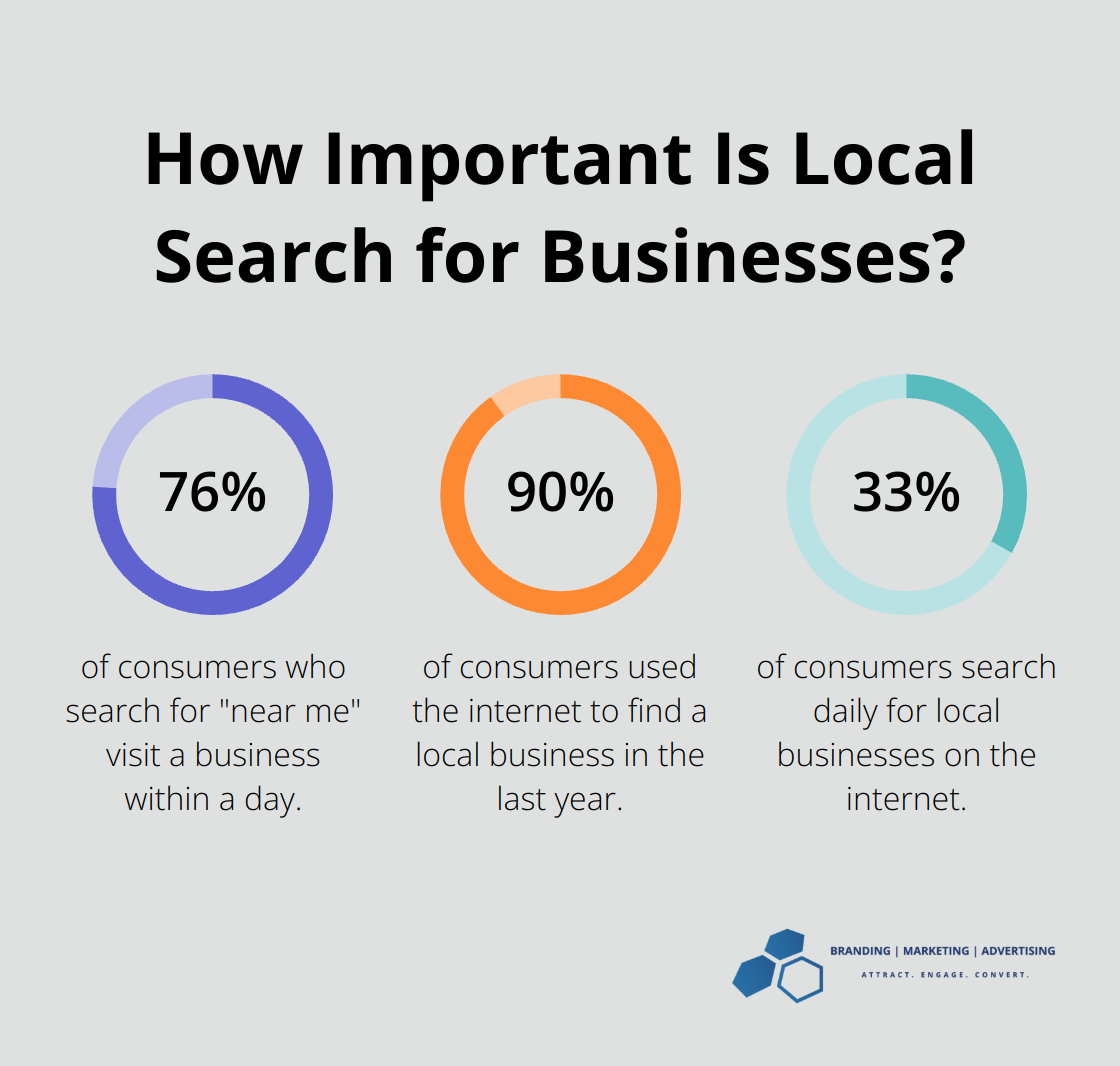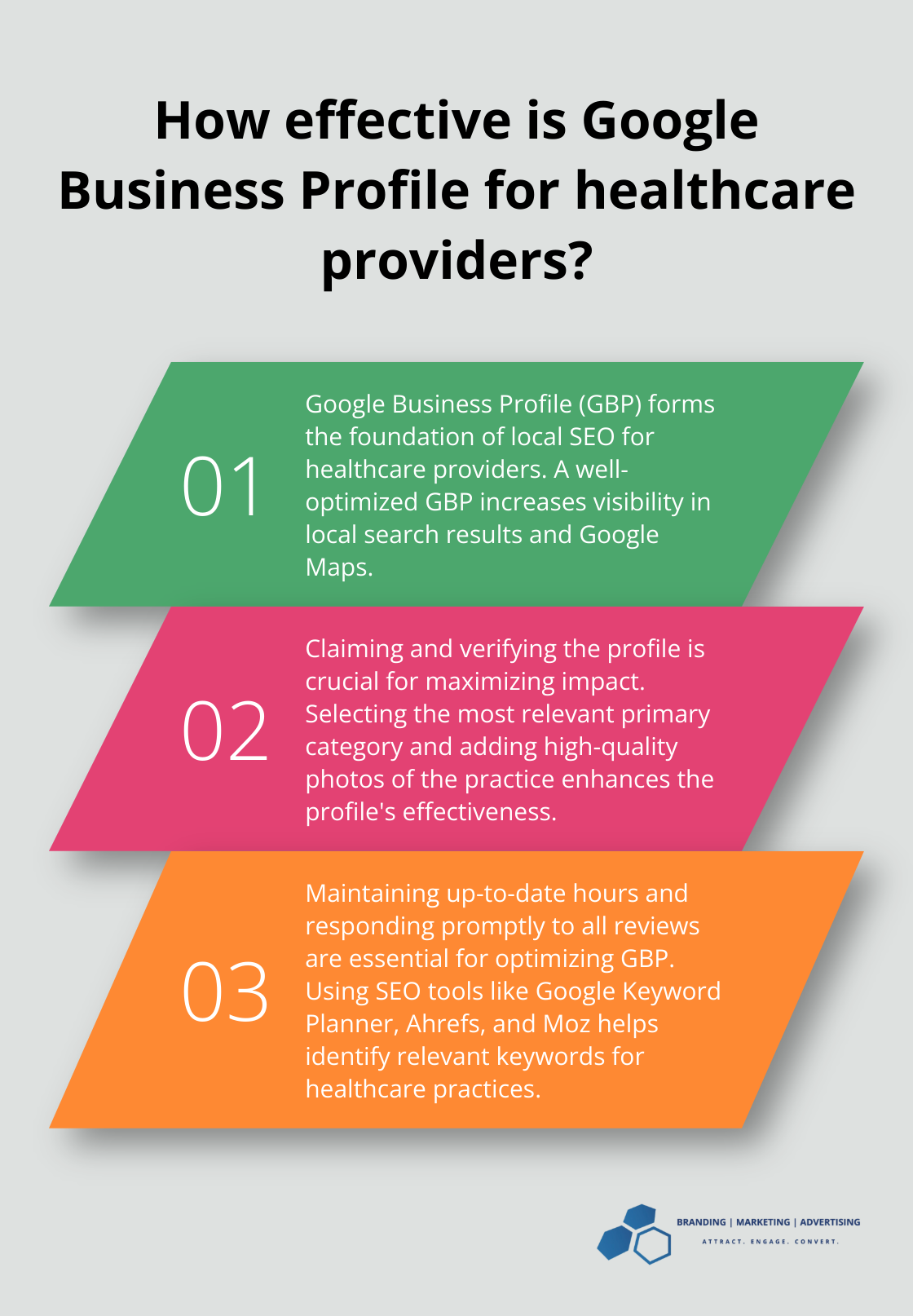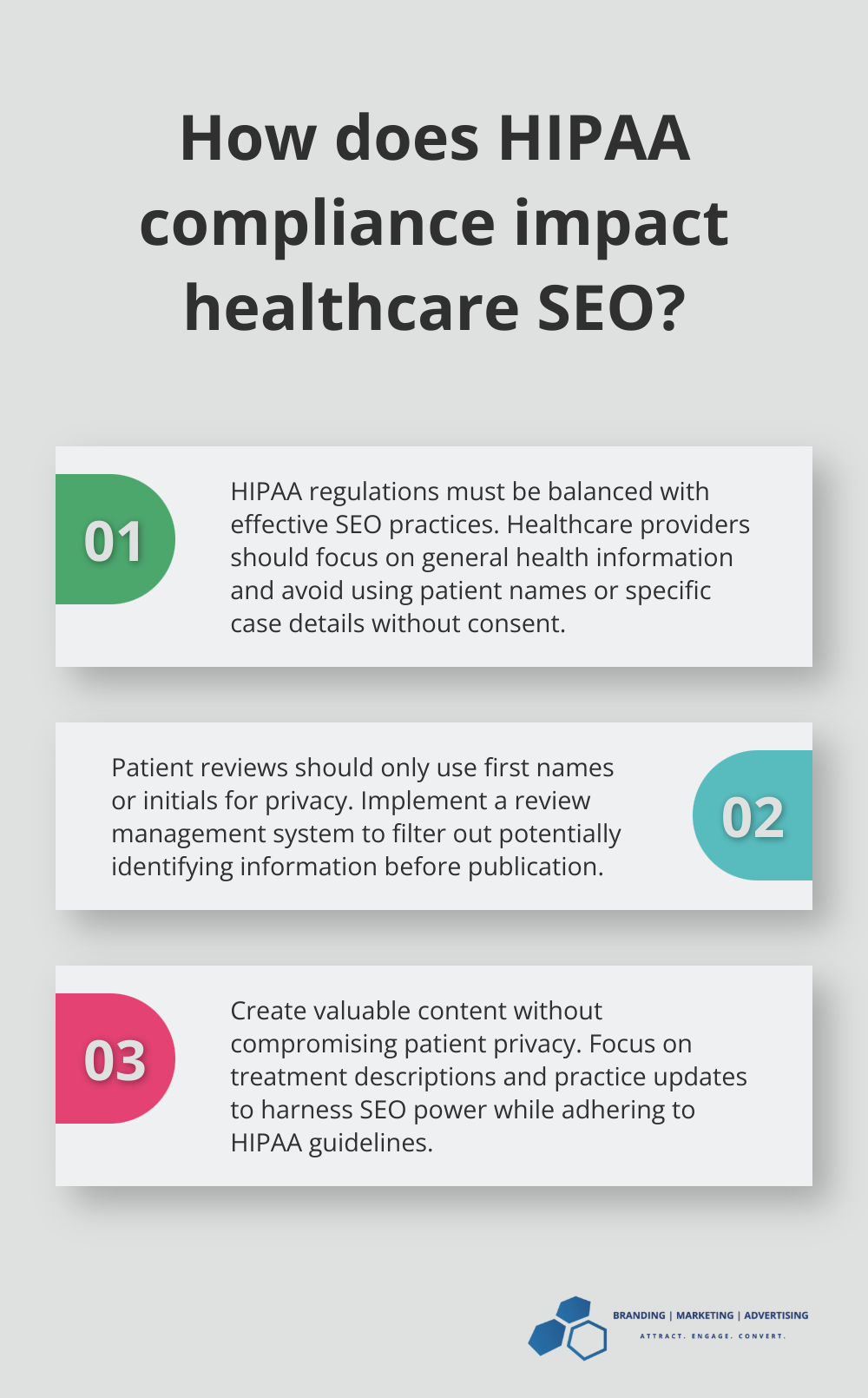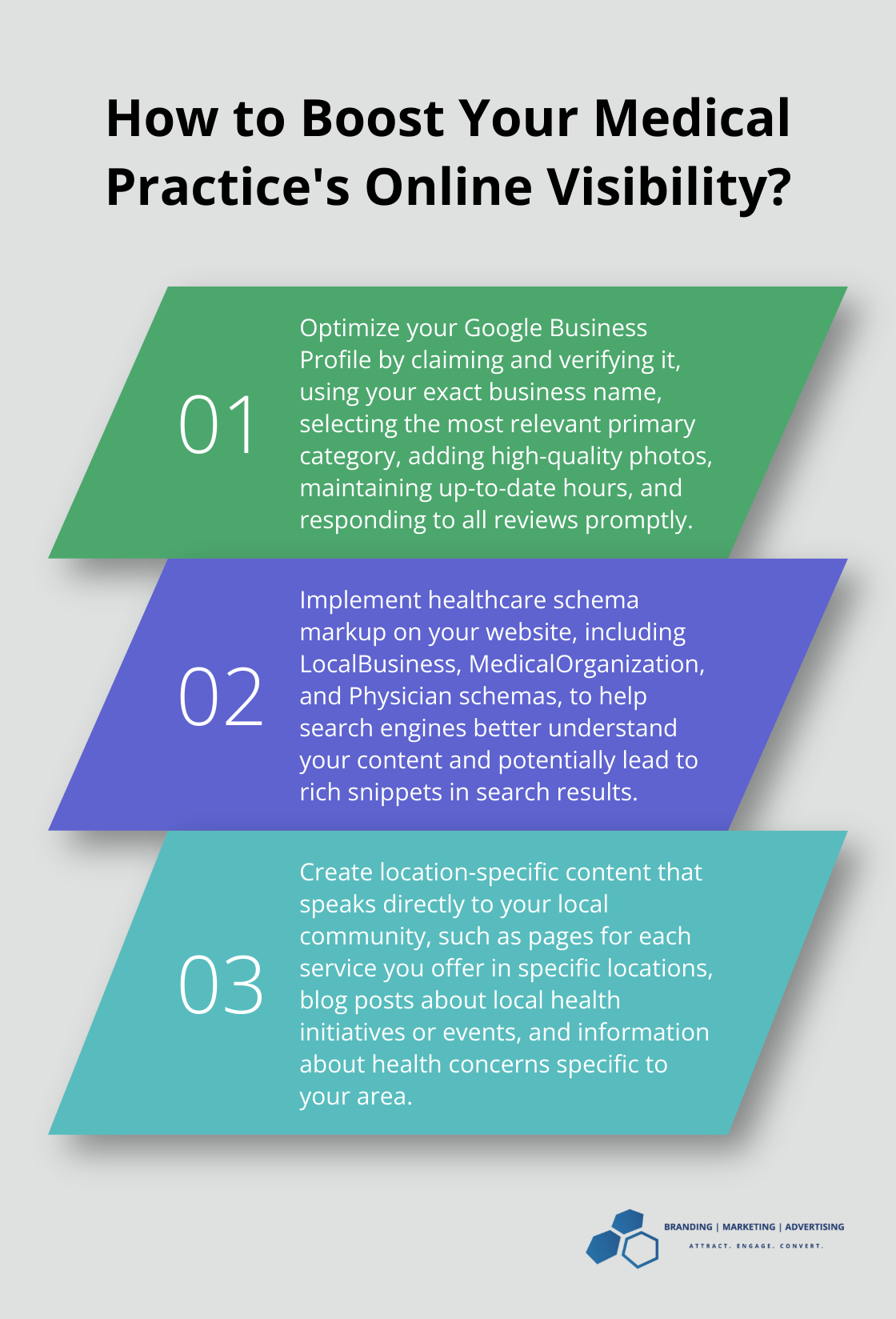Mastering Local SEO for Healthcare Providers [Guide]
Healthcare SEO is a game-changer for medical practices looking to attract more patients locally. At Branding | Marketing | Advertising, we’ve seen firsthand how a well-executed local SEO strategy can transform a healthcare provider’s online presence.
In this guide, we’ll walk you through the essential steps to master local SEO for your healthcare practice. From optimizing your Google Business Profile to managing patient reviews, we’ll cover everything you need to know to boost your visibility in local search results.
What Is Local SEO for Healthcare?
The Essence of Local SEO in Healthcare
Local SEO transforms how healthcare providers connect with patients in their area. It optimizes your online presence for location-based searches. When potential patients search for “dentist near me” or “family doctor in [city name],” an effective local SEO strategy ensures your practice appears at the top of the results.
The Impact of Local Search on Healthcare Practices
Research shows that 76% of consumers who search for “near me” visit a business within a day. This statistic underscores the immense potential for healthcare providers to attract patients actively seeking medical services in their vicinity.
Key Factors Influencing Local Search Rankings
Google’s local search algorithm evaluates three primary factors:
- Relevance: How well your business matches the searcher’s query
- Distance: The proximity of potential search results to the location term used
- Prominence: The reputation and recognition of your practice

To improve these factors, focus on optimizing your Google Business Profile, maintain consistent NAP (Name, Address, Phone number) information across the web, and cultivate a strong review profile.
Tangible Benefits for Healthcare Practices
A robust local SEO strategy yields significant advantages for healthcare providers. BrightLocal’s study found that 90% of consumers used the internet to find a local business in the last year (with 33% searching daily).
For healthcare practices, increased visibility leads to:
- A surge in new patient appointments
- Enhanced trust and credibility within the community
- A competitive edge against larger healthcare systems
Tracking Local SEO Success
To measure the effectiveness of your local SEO efforts, monitor these key metrics:
- Google Business Profile views and actions
- Local pack rankings for important search terms
- Website traffic originating from local searches
- Phone calls and direction requests from your Google Business Profile
The Role of Patient Reviews in Local SEO
Patient reviews play a pivotal role in local SEO success. They influence both search rankings and patient decision-making. Encourage satisfied patients to leave reviews and respond promptly (and professionally) to all feedback, both positive and negative.
Mobile Optimization: A Local SEO Necessity
With the majority of local searches occurring on mobile devices, your website must offer a seamless mobile experience. Google prioritizes mobile-friendly sites in its search results, making mobile optimization a non-negotiable aspect of your local search optimization strategy.
As we move forward, let’s explore the essential local SEO strategies that will elevate your healthcare practice’s online presence and attract more patients to your door.
Proven Local SEO Tactics for Healthcare Providers
Optimize Your Google Business Profile
Your Google Business Profile (GBP) forms the foundation of local SEO. To maximize its impact:
- Claim and verify your profile
- Use your exact business name
- Select the most relevant primary category
- Add high-quality photos of your practice
- Maintain up-to-date hours
- Respond to all reviews promptly

A well-optimized GBP will increase your visibility in local search results and Google Maps. Use SEO tools like Google Keyword Planner, Ahrefs, and Moz to identify keywords relevant to healthcare and your specific practice area.
Build and Manage Local Citations
Consistent citations across the web reinforce your practice’s credibility. Focus on:
- Major directories (Yelp, Healthgrades, RateMDs)
- Local directories specific to your area
- Industry-specific directories for healthcare providers
Ensure your Name, Address, and Phone number (NAP) remain identical across all listings. This consistency signals to search engines that your information is trustworthy.
Create Location-Specific Content
Develop content that speaks directly to your local community. This might include:
- Pages for each service you offer in specific locations
- Blog posts about local health initiatives or events
- Information about health concerns specific to your area
For example, if you’re a dermatologist in Phoenix, create content about sun protection tailored to the Arizona climate.
Leverage Patient Reviews
Patient reviews are vital for both SEO and patient trust. To maximize their impact:
- Set up an automated system to request reviews after appointments
- Respond to all reviews (both positive and negative)
- Feature testimonials on your website
- Address concerns raised in negative reviews to show responsiveness
Recent studies have found that consumers’ trust is positively associated with some aspects of digital healthcare.
Implement Healthcare Schema Markup
Schema markup helps search engines understand your content better. For healthcare providers, consider implementing:
- LocalBusiness schema
- MedicalOrganization schema
- Physician schema (for individual doctor profiles)
This structured data can lead to rich snippets in search results, increasing your visibility and click-through rates.
Local SEO requires ongoing effort and adaptation. Monitor your rankings, update your content, and adjust your strategy based on performance metrics. As you implement these tactics, you’ll notice improved visibility and a steady increase in new patient inquiries. However, local SEO is just one piece of the puzzle. Let’s explore how to overcome common challenges that healthcare providers face when implementing these strategies.
Navigating Healthcare SEO Hurdles
HIPAA Compliance and SEO
Healthcare providers must balance effective SEO practices with HIPAA regulations. Create valuable content without compromising patient privacy. Focus on general health information, treatment descriptions, and practice updates. Avoid using patient names or specific case details in content or testimonials without explicit consent.

For patient reviews, use only first names or initials. Implement a review management system that filters out potentially identifying information before publication. This approach harnesses the power of patient feedback for SEO while adhering to HIPAA guidelines.
Multi-Location Practice SEO
Managing SEO for multiple locations requires a strategic approach. Create individual location pages on your website, each optimized for its specific area. Include unique content about the local community, staff, and services offered at that location.
Develop a system to manage multiple Google Business Profiles. Use a centralized dashboard to ensure consistency across all listings while allowing for location-specific information. Conduct regular audits of your citations across the web to maintain NAP consistency (a crucial factor in local search rankings).
Standing Out in Competitive Markets
In saturated healthcare markets, differentiation is key. Identify your unique selling propositions and highlight them across your online presence. This could include specialized services, cutting-edge technology, or exceptional patient care.
Create in-depth content that showcases your expertise. For example, if you’re a dermatologist in a competitive market, produce a series of detailed blog posts or videos about advanced skincare treatments you offer. This helps with SEO and positions you as a thought leader in your field.
Leverage local partnerships and community involvement to build backlinks and enhance your local relevance. Sponsor local health events or partner with complementary businesses to create unique content and services that set you apart from competitors.
Maintaining Patient Trust
While optimizing for search engines, prioritize patient trust. Provide accurate, up-to-date information about your services, staff, and facilities. Address common patient concerns in your content to build confidence and demonstrate your commitment to patient care.
Showcase your credentials, certifications, and awards prominently on your website. This not only helps with SEO (through structured data markup) but also reinforces your expertise to potential patients.
Adapting to Algorithm Changes
Search engine algorithms evolve constantly. Stay informed about updates and adjust your strategy accordingly. Monitor your rankings and traffic regularly (using tools like Google Analytics and Search Console). Be prepared to make changes to your website and content strategy as needed.
Consider partnering with a reputable SEO agency (like Branding | Marketing | Advertising) that specializes in healthcare marketing. They can help you navigate algorithm changes and implement best practices tailored to the healthcare industry.
Final Thoughts
Local SEO empowers healthcare providers to connect with patients in their community. Healthcare SEO requires consistent effort, monitoring, and adaptation to changing algorithms and patient needs. Regular content updates, review responses, and strategy refinements based on performance metrics will keep your practice visible in local search results.

Increased website traffic, phone calls, and new patient appointments will likely follow successful implementation of these local SEO tactics. Patient privacy concerns and HIPAA compliance must balance SEO efforts, always prioritizing patient trust and confidentiality in online marketing. Our team at Branding | Marketing | Advertising specializes in helping healthcare providers navigate local SEO complexities.
We develop tailored strategies to enhance online presence, attract more patients, and grow practices. Our partnership allows you to focus on excellent patient care while we manage digital marketing intricacies. Start implementing these strategies today to stand out, connect with patients, and thrive in your community through improved online visibility and patient acquisition.












